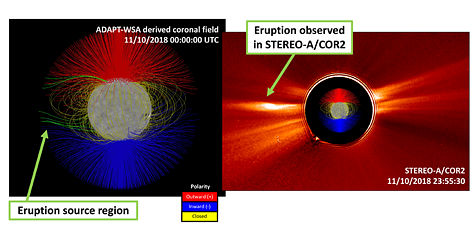Early Career Scientist Spotlight
Dr. Samantha Wallace
Solar Physicist
Solar Physics Laboratory (671)
What is your research focus?
My research investigates the physical processes that drive solar wind formation. Solar wind formation includes everything from the origin of the plasma in the Sun’s atmosphere to how the plasma is heated, released, and accelerated. I use ADAPT-WSA (the Air Force Data Assimilative Flux Transport and Wang-Sheeley-Arge model; a well-known model in the Heliophysics community) to derive the magnetic field of the outer solar atmosphere called the corona. Then, we use the model output to determine precisely where the solar wind observed at the spacecraft came from on the Sun. This reveals the plasma conditions at the site where the solar wind was formed (i.e., magnetic activity, related to the temperature of the plasma). This information cannot be obtained with observations alone. I use ADAPT-WSA output to validate and test solar wind heating and acceleration theories, and to characterize the solar wind emerging from specific sources.
What is one research project that you are particularly excited about, and why?
I’m most excited about the research I proposed for my NASA Postdoctoral Program (NPP) fellowship. In this work, we are using the ADAPT-WSA model to investigate what drives the formation of solar wind that originates from coronal streamers. Streamers are large, bright, dome-like structures extending through the solar atmosphere that converge to a point in the corona. They are visible during solar eclipses because electrons that are either trapped along magnetically “closed” loops or funneling outward on magnetically “open” flux tubes emit at visible wavelengths. There are two types of coronal streamers – helmet streamers and pseudostreamers – with different magnetic polarities, and they are thought to produce two different types of solar wind. However, localized, magnetic “active regions” are known to produce hotter and denser solar wind and are often found underlying the streamer. We are investigating whether the solar wind formed by coronal streamers is more dependent on either the type of streamer (related to the overall magnetic polarity of the structure), or the presence or absence of active regions. The ability to conduct this study is unique because it is not possible without the use of a model.
Click for larger image
Credit: Samantha Wallace
What inspired you to pursue a career in Heliophysics?
As an adolescent, I attended an astronomy night at a state park in Pennsylvania. It was there that I saw Mars for the first time. The fact that I could see Mars from Earth, with my own two eyes unassisted by a telescope, was mind-blowing to me. Ever since then I wanted to be what I called “an astronomer” at the time.
Fast forward to undergrad, where I decided to pursue a bachelors in Space Physics. To be honest, at 17 years old, just the name of the program alone sounded cool. The core of the program was physics coursework, but it included several astronomy courses. I realized in undergrad there are several subdisciplines of this broader field that I called “astronomy” – planetary science, cosmology, astrophysics, etc. The program I was in focused on understanding the natural phenomena that occur in our solar system, primarily caused by the Sun.
As a junior, I applied for several Research Experience for Undergraduates (REU) internships in Astrophysics. I only was accepted into one program, at the National Solar Observatory. I wondered if I would like it, because I never thought I would study just one star. However, it was during this internship that I decided I wanted to be a Solar Physicist.
At the time, NASA’s Solar TErrestrial RElations Observatory (STEREO) had just taken the first-ever 360-degree observations of the solar corona, and the Solar Dynamics Observatory (SDO) had recently launched. I was quickly amazed by the wealth of high-resolution observations we had of the Sun compared to other celestial objects. These observations allow us to dig deeper into the physics heating and accelerating the coronal plasma. Investigating these processes on the Sun also helps us to understand the dynamics that occur on other stars. My project involved using extreme ultraviolet (EUV) observations from STEREO and SDO to identify active regions, track them across the solar disk, and compare how they appeared at different wavelengths (i.e., at different layers of the solar atmosphere). I was so excited to use new observations and conduct research that was not possible just a few months prior to my internship. I was also amazed that I could study one specific aspect of the Sun in detail, as opposed to only being able to resolve the star as a whole.
What is one of your favorite moments in your career so far?
Hands-down, my favorite moment of my career was seeing the 2017 total solar “Eclipse Across America” in Salem, Oregon. This eclipse was the most beautiful and awe-inspiring event in nature that I’ve ever witnessed. During a total solar eclipse, the moon covers the entire solar disk, allowing us to see the outermost layer of the solar atmosphere, the corona, with our naked eye.
At the time, I was doing research on the solar wind that originates from pseudostreamers. During the eclipse, I was able to watch coronal plasma moving underneath a pseudostreamer through binoculars!!
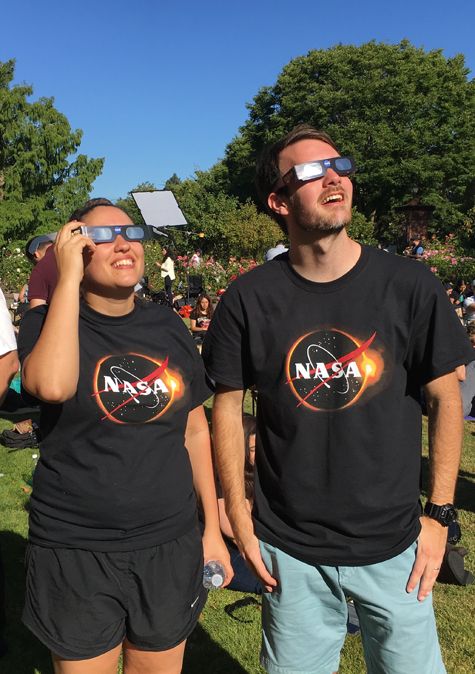
Credit: Samantha Wallace
What is an interesting problem or hurdle that you’ve overcome in your career?
The hurdle that I progressively overcome, and that instinctively comes to mind when I hear a question like this is the fact that I am a female, first-generation college graduate in the science community. It has taken me several years to become aware of how these facets of my identity play into my career. There are many ways in which my upbringing was culturally different than my peers. One primary example of this is the way education was portrayed to me by my family. I didn’t have any family members to look to as academic role models, to assist with applying to college or scholarships, let alone going to grad school and getting my PhD. I relied on my high school guidance counselors, college professors, and graduate school advisors when trying to figure out my next steps. Even still, there were several obstacles that I had to figure out brute force on my own. If it weren’t for all the amazing people in my life that helped me along the way, I wouldn’t have made it this far academically.
Looking back, I am thankful for the character that has been formed in me from my obstacles and challenges. I am passionate about supporting the next generation of early-career women in STEM and first-generation college grads, and inspiring them to persevere.
What is a fun fact about you?
At age 19, I studied aboard through a program called Semester at Sea. In one semester I circumnavigated the world on a cruise liner, and visited 8 different countries throughout Asia, Africa, and South America. Onboard the ship, I took classes that were related to the countries we were visiting. I had the opportunity to visit world wonders such as the Great Wall of China and the Taj Mahal, experience Chinese New Year, interact with wildlife up close in South Africa, and spend a few nights in a hammock on a house boat in the Amazon. I also participated in field-directed practicum for my coursework, including visiting schools and mental hospitals abroad. However, the most impactful part of this trip was connecting with people in each country.
This experience defined my formative, young adult years, and cultivated a love and respect in me for other cultures and communities. Since this trip, I have been back to Africa twice for mission work, studied abroad in New Zealand, and traveled around Australia and Europe.
Nowadays, I spend most of my time with my family. My husband and I recently had our first baby, and we love every minute with our little guy!
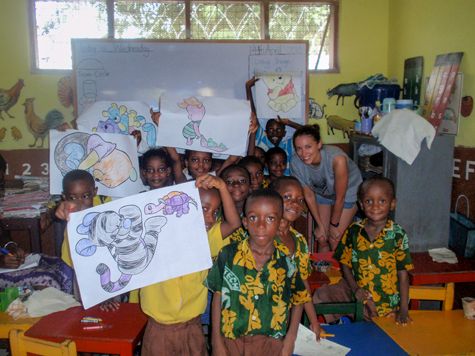
Credit: Samantha Wallace
What advice would you give your younger self?
So much of life unfolds as you go. The road less travelled can still lead to you achieving your goals. Stop comparing yourself to others. Work hard, pursue what you are passionate about, plan for what you can, but in the end be open and let your experiences shape you.
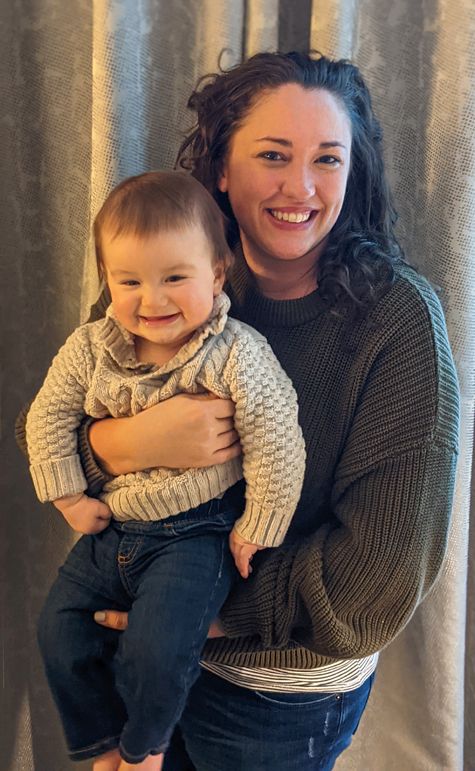
Credit: Samantha Wallace
Biography
Home Town:
Buffalo, NY
Undergraduate Degree:
Bachelor of Science in Space Physics (2012), Embry-Riddle Aeronautical University, Daytona Beach, FL
Post-graduate Degrees:
Master's in Engineering Physics (2015), Embry-Riddle Aeronautical University, Daytona Beach, FL
Ph.D. in Physics (2020), University of New Mexico, Albuquerque, NM
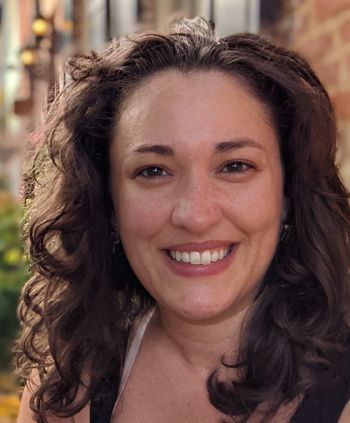
Link to Dr. Wallace's GSFC Bio

